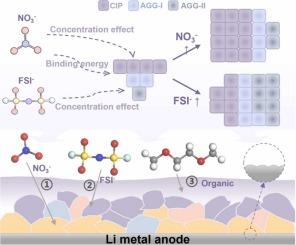逆转氮/氟在固体电解质间相的分布使锂金属阳极具有高度可逆性
IF 17.1
1区 材料科学
Q1 CHEMISTRY, PHYSICAL
引用次数: 0
摘要
坚固的固体电解质界面(SEI)是构建高性能锂金属电池(LMB)的关键。在这里,我们使用双盐电解质设计了一种独特的分层SEI膜,具有氮化物和氟化物的反向梯度分布。值得注意的是,溶剂化结构,特别是聚集体(AGG)受到浓度效应和不同阴离子与锂离子之间的结合能差异的影响。通过对AGG的精细调节,可以控制阴离子分解过程,从而优化SEI膜的组分比例。因此,优化后的电解质达到99.50%的高CE,并确保无枝晶锂沉积。LMB (50 μm Li|| LiFePO4, N/P比为3)经过300次循环后,容量保持率高达90%。本工作不仅为稳定的lmb开发了一种新颖而优良的电解质,而且揭示了溶剂化结构与SEI组分/结构之间的内在机理。本文章由计算机程序翻译,如有差异,请以英文原文为准。

Reversing nitride/fluoride distribution in the solid electrolyte interphase enables a highly reversible lithium metal anode
A robust solid electrolyte interphase (SEI) is essential for constructing high-performance lithium-metal battery (LMB). Here, we designed a unique layered SEI film with a reverse gradient distribution of nitride and fluoride compounds using a dual-salt electrolyte. Notably, the solvation structures, especially aggregates (AGG) are influenced by both the concentration effect and the binding energy differences between different anions and lithium ions. Through finely adjusting AGG, the anion decomposition processes can be controlled, thereby optimizing the component ratio of SEI film. As a result, the optimized electrolyte achieves a high CE of 99.50 % and ensures dendrite-free lithium deposition. The LMB (50 μm Li|| LiFePO4, N/P ratio is 3) achieves high capacity retention rate of 90 % after 300 cycles. This work not only develops a novel and excellent electrolyte for stable LMBs, but also reveals the internal mechanisms between solvation structure and SEI component/structure.
求助全文
通过发布文献求助,成功后即可免费获取论文全文。
去求助
来源期刊

Nano Energy
CHEMISTRY, PHYSICAL-NANOSCIENCE & NANOTECHNOLOGY
CiteScore
30.30
自引率
7.40%
发文量
1207
审稿时长
23 days
期刊介绍:
Nano Energy is a multidisciplinary, rapid-publication forum of original peer-reviewed contributions on the science and engineering of nanomaterials and nanodevices used in all forms of energy harvesting, conversion, storage, utilization and policy. Through its mixture of articles, reviews, communications, research news, and information on key developments, Nano Energy provides a comprehensive coverage of this exciting and dynamic field which joins nanoscience and nanotechnology with energy science. The journal is relevant to all those who are interested in nanomaterials solutions to the energy problem.
Nano Energy publishes original experimental and theoretical research on all aspects of energy-related research which utilizes nanomaterials and nanotechnology. Manuscripts of four types are considered: review articles which inform readers of the latest research and advances in energy science; rapid communications which feature exciting research breakthroughs in the field; full-length articles which report comprehensive research developments; and news and opinions which comment on topical issues or express views on the developments in related fields.
 求助内容:
求助内容: 应助结果提醒方式:
应助结果提醒方式:


